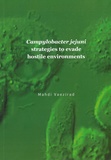Campylobacter jejuni strategies to evade hostile environments

Vaezirad, Mahdi
- Promoter:
- Prof.dr. J.P.M. (Jos) van Putten
- Research group:
- Putten
- Date:
- September 19, 2017
- Time:
- 12:45 h
Summary
Campylobacter jejuni is the most common cause of human bacterial foodborne disease in the western world. Each year hundreds of millions of cases of Campylobacter infection occur worldwide. After a few weeks, the infection may be followed by serious auto-immune diseases like the Guillain-Barre syndrome. One major source of Campylobacter is contaminated chicken meat. Up to 70% of the chicken meat sold in the supermarkets is contaminated with Campylobacter. Despite the huge health problems associated with Campylobacter, there are currently no remedies to prevent the colonization of the chicken gut. It is also not known why Campylobacter acts as an innocent commensal bacterium in the chicken and why its shows pathogenic behavior once ingested by humans. The main purpose of this research was to provide a fundamental new understanding of the bacterial and host mechanisms that determine Campylobacter behavior in the gut in order to develop novel protection strategies. We demonstrate the exceptional qualities of Campylobacter to adapt to changing environments either through internal metabolic adaptation, active alteration of the external environment, or the modulation of host cell biology. We show that Campylobacter has the intrinsic ability to pass the mucosal barrier and spread to the liver in immunosuppressed animals. We demonstrate that the steroids suppress the innate immune response of chicken macrophages towards bacterial antigens, meaning that, under healthy conditions, the local host defense may contribute to the commensal behavior of Campylobacter in the chicken gut. The results imply that chicken stress which results in increased levels of glucocorticoids may weaken the immune system and thus enhance the susceptibility of chicken to infection. In the search for bacterial factors that contribute to the survival of Campylobacter in the chicken, we discovered that amino acid metabolism of Campylobacter influences the pH of the microenvironment. This way Campylobacter can create its own optimal local pH habitat and reduce the need of individual bacteria to continuously adapt to a suboptimal external pH. This saves energy. We identified the bacterial metabolites that enabled the adaptive pH changes and show a direct relationship between the metabolism of E. coli and C. jejuni in the regulation of the environmental pH. Besides important inter-bacterial communication, we discovered that metabolic cross-talk between Campylobacter and chicken macrophages. Campylobacter neutralizes host-derived nitric oxide (NO), one of the most important intracellular regulators of inflammation. By scavenging NO Campylobacter influences host proteins that regulate the host immune response. This metabolic cross-talk between the bacterium and its host adds a new dimension to the virulence repertoire of Campylobacter and offers opportunities for the development of novel infection intervention strategies. Overall, our results indicate that Campylobacter has evolved a number of strategies to colonize and survive in the chicken gut. Our findings classify Campylobacter as an opportunistic pathogen in chicken and suggest that under healthy conditions it is an active member of the large microbiota community that through its metabolism actively interacts with the mucosal tissues and immune system of the host. The bacterial survival strategies identified in the present study novel targets and a new perspective for the development innovative solutions to reduce the worldwide problem of Campylobacter disease.